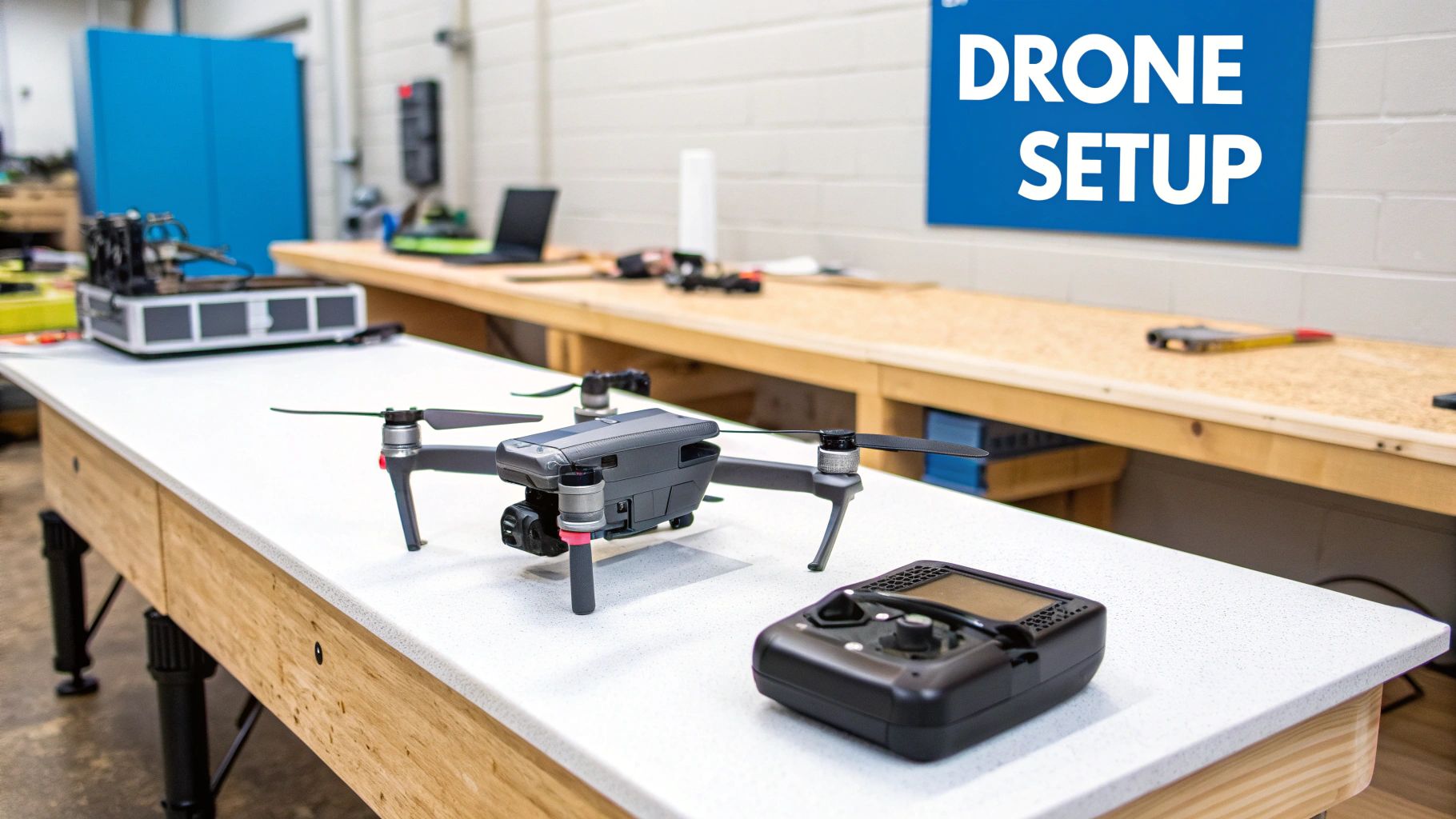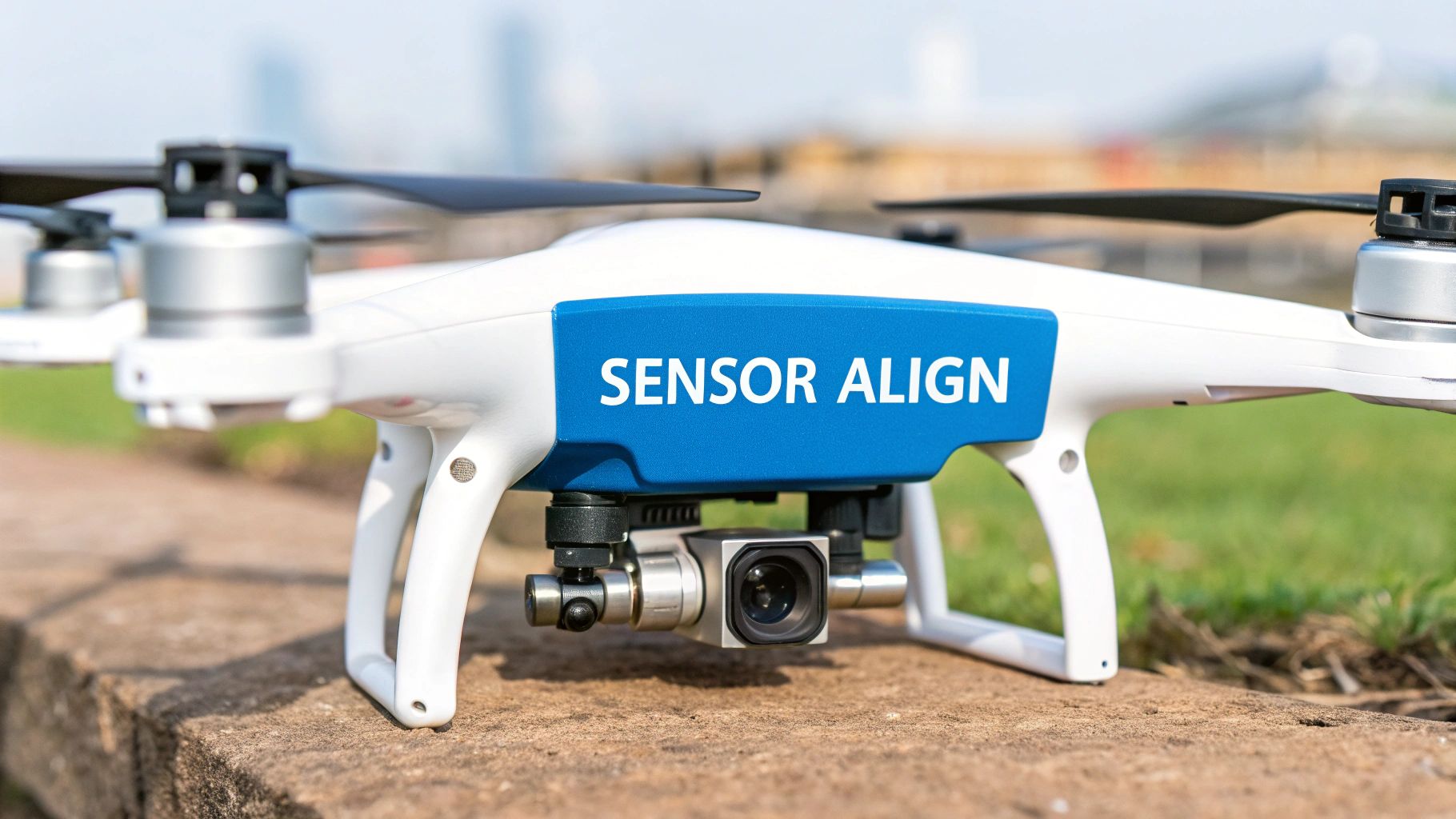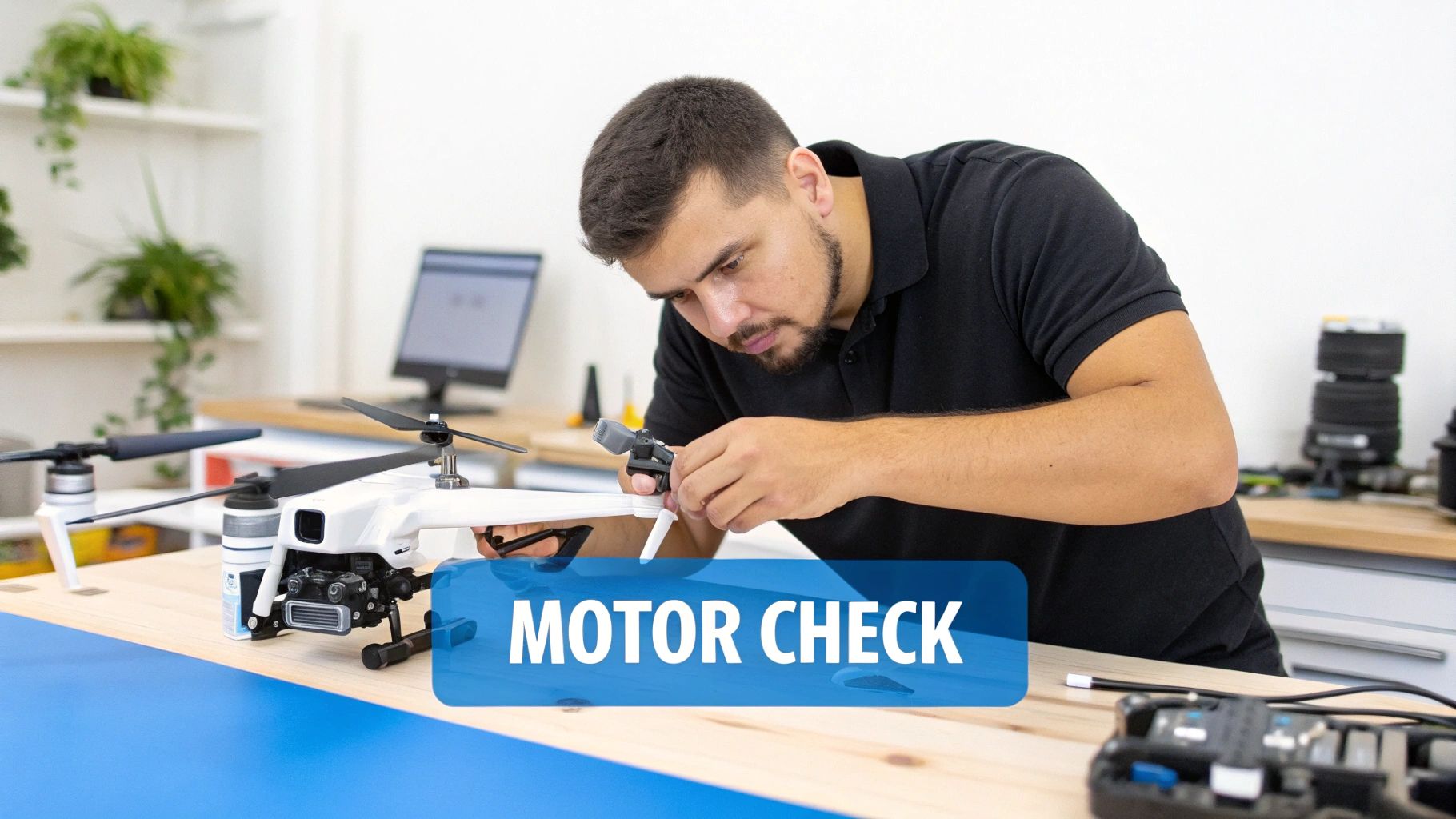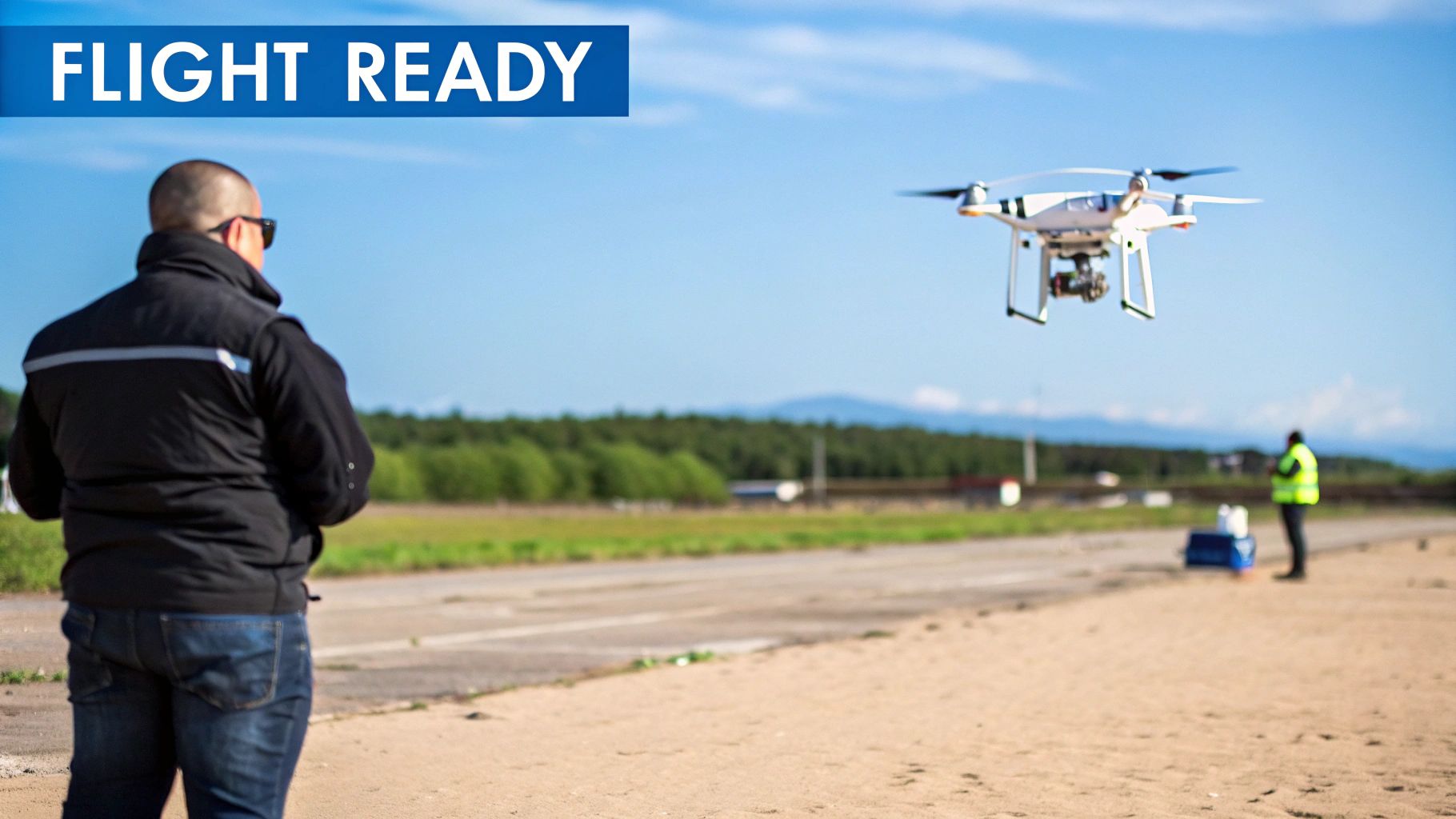How to Calibrate a Drone: Quick Expert Guide
- A.E. Williams

- Apr 21
- 11 min read
Why Drone Calibration Makes or Breaks Your Flight Experience

Uncalibrated drones can be a safety risk. Calibration is essential for a good drone flight, ensuring your drone operates as intended. Ignoring this crucial step can cause problems ranging from frustrating drifts to potential crashes. When calibrating, consider showcasing the process and benefits through video. Educational video production can be a valuable tool for demonstrating this.
How Calibration Impacts Flight Performance
Calibration directly impacts your drone's functionality. It affects flight stability. A well-calibrated drone holds its position and responds predictably. An uncalibrated drone might drift, wobble, or fly erratically. This is especially important for aerial photography and videography.
Calibration also impacts battery life. A drone fighting to correct its position due to poor calibration will drain its battery faster. This leads to shorter flight times.
Finally, calibration enhances video quality. It ensures the gimbal, which stabilizes the camera, operates smoothly and accurately. This results in stable, professional footage.
Calibrating the Compass and IMU
Proper calibration of the drone's compass and IMU (Inertial Measurement Unit) is crucial. This compensates for magnetic interference and sensor drift, which can cause unstable flight and navigation errors.
Poor calibration has been linked to drone flight failures. Some estimate that up to 30% of failures, especially in commercial applications like mapping and surveying, are due to inadequate calibration. Find more detailed statistics here. This emphasizes the importance of proper drone calibration.
Recognizing the Warning Signs
Several signs indicate your drone needs calibration. Noticeable drifting, difficulty hovering, and erratic movements are key indicators.
If your drone struggles to follow its flight path or the video is shaky despite a working gimbal, calibration is likely the solution. Addressing these issues through calibration improves performance and can extend the drone's lifespan by reducing stress on its components.
Pre-Flight Calibration Routine
A pre-flight calibration routine is a proactive step towards safer and more enjoyable flights. Taking a few minutes to calibrate before each flight ensures optimal performance and minimizes mid-flight issues. This leads to a more successful drone experience.
Core Components That Demand Perfect Calibration

A stable and responsive drone relies on the precise interplay of several calibrated components. This isn't just a technical detail; it's fundamental to effective drone operation. These components work together to ensure a smooth and controlled flight. Let's explore these key components and their individual roles.
The Inertial Measurement Unit (IMU)
The IMU acts as the drone's internal guidance system, constantly measuring its acceleration and angular velocity. It's similar to our own sense of balance. This data is essential for the drone's flight controller to maintain stability and execute commands accurately.
If the IMU is miscalibrated, the drone might unexpectedly tilt or drift, even in calm conditions. This can make precise maneuvers or hovering challenging, especially for tasks like aerial photography. Proper IMU calibration is vital for optimal drone performance.
The Compass: Navigating the Magnetic Field
The compass provides the drone with directional awareness. This allows it to maintain its heading and navigate effectively. It interacts with the Earth's magnetic field, just like a traditional compass.
Magnetic interference from nearby metal objects or electronic devices can disrupt compass readings. This interference can lead to the drone flying in the wrong direction or failing to return to its home point accurately.
Gimbal Calibration: Ensuring Smooth Footage
For camera drones, gimbal calibration is also essential. The gimbal stabilizes the camera, isolating it from the drone's movements. This ensures smooth, professional-looking footage.
A miscalibrated gimbal can result in shaky or tilted videos, impacting video quality. This is particularly important for professional drone operators who need high-quality footage. You might be interested in: How to master....
The importance of calibration services is underscored by the growth of the global calibration services market. It's projected to grow from USD 5.7 billion in 2023 to USD 8.1 billion by 2030. This growth reflects the increasing demand for accuracy across various technologies. Explore this topic further
The following table details the core drone components requiring calibration. It outlines their functions, recommended calibration frequencies, and the consequences of neglecting this crucial maintenance step.
Component | Function | Recommended Calibration Frequency | Consequences of Poor Calibration |
|---|---|---|---|
IMU | Measures acceleration and angular velocity, crucial for stability and control | Before each flight or after a crash/impact | Drifting, tilting, difficulty hovering, inaccurate flight control |
Compass | Provides directional awareness and heading information | Before each flight, especially in new locations | Inaccurate flight path, failure to return to home, disorientation |
Gimbal | Stabilizes the camera, isolating it from drone movements | As needed, especially if footage is shaky or tilted | Shaky or tilted video footage, reduced video quality |
This table summarizes the critical components that require regular calibration for optimal drone performance and safety. Ensuring these components are properly calibrated is key for a successful flight and capturing high-quality footage.
Mastering IMU Calibration: The Heart of Stable Flight

While other components contribute, the IMU (Inertial Measurement Unit) is the most critical sensor for stable drone flight. It acts like the drone’s inner ear, constantly feeding information about its orientation and movement in 3D space. Mastering IMU calibration is key to achieving professional-level flight control, ensuring your drone accurately interprets its position and movement.
Understanding the IMU's Importance
The IMU comprises accelerometers and gyroscopes. Accelerometers measure linear acceleration, informing the drone about its speed in any direction. Gyroscopes measure angular velocity, or how fast the drone rotates around each axis. The flight controller uses this data to adjust the motors, maintain a stable hover, and execute precise movements.
Even slight IMU miscalibration can cause noticeable drift, unwanted tilting, and difficulty maintaining a steady hover. For instance, a miscalibrated gyroscope might cause the drone to constantly rotate slightly, leading to drift. Accurate IMU calibration is vital for tasks requiring fine-tuned control, such as aerial photography.
Step-by-Step IMU Calibration
Specific calibration steps vary depending on the drone model, but general principles remain consistent. Most drones have automated routines accessible through companion apps. Here’s a generalized IMU calibration process:
Level Surface: Place the drone on a perfectly level surface using a spirit level for accuracy. This is crucial for proper calibration.
Initiate Calibration: Access your drone’s companion app and navigate to the calibration settings. Select the IMU calibration option.
Follow the Prompts: The app will guide you through specific rotations. Follow these prompts carefully for accurate calibration.
Confirmation: Upon completion, the app or drone should provide confirmation, like a change in LED patterns or an app notification.
Troubleshooting IMU Calibration Issues
Calibration might not always succeed on the first try. Common issues include persistent error messages, calibrations that don’t last, or erratic drone behavior after calibration.
Environmental Factors: Temperature affects IMU accuracy. Calibrating in extreme temperatures can lead to incorrect readings. Choose a moderate temperature.
Magnetic Interference: Nearby metal or electronic devices can interfere with the IMU. Move away from potential interference sources.
Firmware Updates: Firmware updates can impact calibration. Ensure your drone’s firmware is up-to-date.
This attention to IMU calibration is increasingly important in the expanding commercial drone market. Advancements in calibration technology are key to integrating artificial intelligence and autonomous flight. The consumer drone segment is growing at a CAGR of 17.26% from 2022 to 2029, driven by improved calibration routines enabling precise obstacle detection and navigation. Discover more insights about market growth. These improvements pave the way for more reliable drone operations.
Maintaining Calibration and Transporting Your Drone
After calibration, handle your drone carefully to maintain its accuracy. Avoid bumping or jarring the drone during transport. A protective case helps prevent damage to the sensitive IMU components. These practices ensure consistent performance and reduce the need for frequent recalibration, creating a safer, more enjoyable flying experience.
Compass Calibration: Unlocking Precise Navigation

Accurate IMU calibration is fundamental for stable drone flight. However, truly precise navigation hinges on proper compass calibration. This process refines your drone's internal compass, teaching it to interpret its position relative to the Earth's magnetic field. It's like giving your drone an internal GPS, ensuring it maintains a steady course and returns home safely.
Understanding The Importance of Compass Calibration
A drone's compass interacts with the Earth's magnetic field to determine its heading. This field, however, isn't uniform. It's susceptible to magnetic interference from various sources, including metal structures, power lines, and even common electronic devices.
This interference can disrupt the compass, causing inaccurate readings. As a result, the drone might drift, struggle to return home, or become completely disoriented. Proper compass calibration is key to minimizing these risks.
Performing A Compass Calibration
Compass calibration usually involves rotating the drone in specific patterns. This allows the compass to map the local magnetic field and compensate for any interference.
The exact procedure will vary depending on your drone model. Most drones, however, require two main maneuvers:
Horizontal Rotation: Rotate the drone horizontally a full 360 degrees, keeping it level. This calibrates the horizontal axis of the compass.
Vertical Rotation: Rotate the drone vertically, nose up or down, a full 360 degrees. This calibrates the vertical axis.
Most drone companion apps, like the one from DJI, will guide you through these steps with visual and audio cues. Carefully follow these prompts for the most accurate calibration. For additional tips, check out this resource: How to master...
Dealing With Compass Interference
Even after calibration, interference can still happen. Recognizing the signs is essential for safe flight.
Drifting: Noticeable drift, even in calm conditions, suggests possible interference.
Erratic Yaw: Unpredictable yaw (rotation around the vertical axis) is another warning sign.
Return-to-Home Issues: Difficulty returning to the home point might also indicate compass problems.
If you see these signs, recalibrate your compass in a different location, away from potential interference. Many experienced drone pilots create location-specific calibration profiles to account for the unique magnetic characteristics of different flight areas.
Best Practices For Compass Calibration
For the best calibration results, follow these recommendations:
Choose a Clear Area: Calibrate in an open area away from metal objects and electronic devices. Keep a distance of at least 10-15 feet from anything that might cause interference.
Avoid Magnetic Materials: Remove any metallic jewelry or objects you might be carrying. These can affect the readings.
Calibrate Regularly: Calibrate your compass before each flight, especially in new locations. This ensures accurate and consistent performance.
Advanced Techniques For Challenging Environments
Standard calibration may not be enough in some environments. Areas with strong magnetic anomalies, such as mining sites or areas with high iron content in the soil, present unique challenges.
In these cases, advanced techniques may be required. Refer to your drone's documentation or consult experienced drone operators. Solutions might involve specialized calibration tools or firmware adjustments. Understanding these techniques can expand your drone's capabilities in difficult environments. Mastering the relationship between your drone's compass and the surrounding magnetic environment leads to consistently reliable navigation.
Perfect Timing: When and Where to Calibrate Your Drone
Calibrating your drone is more than a one-time setup. Knowing when and where you calibrate is just as crucial as the how. This significantly affects the calibration's effectiveness and your drone's flight performance. Proper timing can mean the difference between a smooth, enjoyable flight and a frustrating experience.
Key Times to Recalibrate
There are several key situations that call for recalibration:
After Travel: Traveling with your drone, especially long distances, can impact its internal sensors. Recalibrating after travel, particularly across time zones or significant latitude changes, ensures accurate compass readings and stable flight.
Firmware Updates: Updates to your drone's firmware can sometimes reset calibration settings or introduce changes affecting sensor performance. Recalibrating after a firmware update is essential. This ensures that everything is functioning as expected.
Crash or Impact: Any impact, even one that seems minor, can disrupt sensor alignment and accuracy. If your drone has crashed, recalibration is crucial to identify potential damage and restore proper function. Even a small bump can shift the delicate sensors inside the IMU (Inertial Measurement Unit), necessitating recalibration.
Performance Issues: Experiencing drifting, erratic behavior, or difficulty hovering? Recalibration is often the first troubleshooting step. This helps rule out calibration errors as the source of the problem.
Choosing the Right Environment
Your environment plays a vital role in successful calibration. Here's what to consider:
Magnetic Interference: Metal objects, power lines, and electronics create magnetic interference. This interferes with compass calibration. Calibrate at least 10-15 feet away from these sources. Think of your drone's compass like a traditional compass – it needs a clear reading to work properly.
Level Surface: A perfectly level surface is essential for IMU calibration. Use a spirit level to ensure absolute accuracy. This ensures your drone correctly understands its initial position.
Temperature: Extreme temperatures can affect sensor accuracy. Calibrate in moderate temperatures for optimal results. Like a musical instrument going out of tune in extreme heat or cold, your drone's sensors are also sensitive to temperature changes.
Altitude and Time of Day Considerations
Altitude and time of day can also influence calibration. Higher altitudes often have different magnetic field strengths. Calibrating at a similar altitude to your intended flight can improve accuracy.
Variations in the Earth's magnetic field throughout the day can also affect results. While not always crucial, calibrating close to your flight time, especially for precise tasks, can enhance accuracy.
Establishing a Calibration Routine
Many professional drone pilots establish location-specific calibration routines. This maximizes their efficiency and accuracy. They often calibrate at their most frequent takeoff points, considering the typical time of day and expected conditions.
By understanding the factors that affect calibration and developing a consistent routine, you'll improve your drone's performance, extend its lifespan, and, most importantly, ensure safer flights. Regular drone calibration acts as a pre-flight check, ensuring each flight starts from a stable and predictable baseline. This proactive approach minimizes in-flight issues, providing greater confidence and control.
Troubleshooting Like a Pro: Solving Stubborn Calibration Issues
Even seasoned drone pilots occasionally run into calibration problems. Knowing how to troubleshoot these issues quickly can make all the difference. This section explores common calibration problems and their solutions, helping you resolve them effectively. Before calibrating, a preflight check is essential, as outlined in this preflight checklist.
Identifying Software Vs. Hardware Problems
One of the first troubleshooting steps is determining whether the issue is software or hardware related. Software issues are often easily fixed, while hardware problems may need professional help.
Software Issues: These often present as persistent error messages during calibration, calibrations that don't save, or slight performance inconsistencies. Restarting the drone, recalibrating, or updating the firmware can sometimes resolve these.
Hardware Problems: Erratic drone behavior, significant drift after multiple calibrations, or visible damage to sensors suggest a hardware problem. This could be a damaged IMU or a faulty compass. Consulting a qualified technician is often the best course of action.
Deciphering Error Patterns
Specific error patterns during calibration can indicate the underlying cause. Carefully review any error messages in your drone's app. For example, a compass error might suggest magnetic interference, while an IMU error might indicate a problem with the accelerometer or gyroscope. More information can be found here.
Step-by-Step Troubleshooting Approaches
The following table offers a guide to common calibration issues and how to address them:
Common Calibration Problems and Solutions This table outlines frequently encountered drone calibration issues, their symptoms, potential causes, and step-by-step troubleshooting solutions.
Problem | Symptoms | Possible Causes | Troubleshooting Steps |
|---|---|---|---|
Compass Calibration Failure | Drone drifts, inaccurate heading | Magnetic interference, compass malfunction | Recalibrate in a different location away from metal objects, restart the drone, contact support if the problem continues |
IMU Calibration Failure | Unstable hover, tilting, erratic movement | Uneven surface, IMU malfunction, firmware issue | Ensure a level surface for calibration, recalibrate, update firmware, contact support if needed |
Calibration Not Saving | Drone loses calibration after restart | Software glitch, corrupted settings | Restart drone and app, reset drone to factory settings, contact support if the issue persists |
Key takeaways from the table include ensuring a proper environment for calibration, checking for obvious issues like magnetic interference, and keeping your drone’s firmware updated. When problems persist, contacting support is advisable.
Emergency Calibration Techniques
Sometimes, field calibrations are necessary with limited resources. Here are some emergency techniques:
Simplified IMU Calibration: If a perfectly level surface isn't available, find the flattest spot you can. Consider using a rock or other object to create a level base.
Visual Compass Calibration: If you think there's compass interference, try visually aligning the drone's heading with landmarks. This can help establish a rough orientation.
Reduced Calibration Movements: In tight spaces, try smaller calibration rotations. This isn't ideal, but it might temporarily improve accuracy.
By learning these troubleshooting techniques, you can turn potential frustrations into quick fixes. This allows you to maximize your flight time and enjoy your drone to its full potential. Check out the JAB Drone for advanced features and capabilities.




Comments